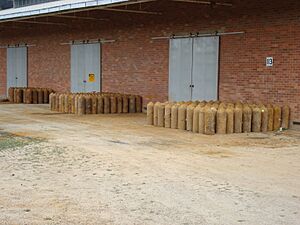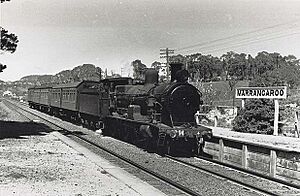Marrangaroo, New South Wales facts for kids
Quick facts for kids MarrangarooNew South Wales |
|||||||||||||||
|---|---|---|---|---|---|---|---|---|---|---|---|---|---|---|---|
| Population | 909 (2016 census) | ||||||||||||||
| Postcode(s) | 2790 | ||||||||||||||
| Elevation | 1,200 m (3,937 ft) | ||||||||||||||
| Location | |||||||||||||||
| LGA(s) | City of Lithgow | ||||||||||||||
| State electorate(s) | Bathurst | ||||||||||||||
| Federal Division(s) | Calare | ||||||||||||||
|
|||||||||||||||
|
|||||||||||||||
Marrangaroo is a small village in the Central West area of New South Wales, Australia. It is part of the City of Lithgow. The name Marrangaroo also refers to the wider area around the village.
Contents
Discover Marrangaroo
Marrangaroo is located just a few kilometres west of Lithgow. You can reach it from the Great Western Highway. There isn't a train station in Marrangaroo, and bus services are limited. However, some buses running between Lithgow and Bathurst do stop along the Great Western Highway.
One well-known spot in Marrangaroo used to be the Trout Farm. It was located across from the Lithgow Correctional Centre. In 2016, about 909 people lived in Marrangaroo.
The north-eastern part of the Marrangaroo area is now part of the beautiful Gardens of Stone State Conservation Area. This area is great for exploring nature.
Marrangaroo's Military History
The Marrangaroo Army Camp is found at the end of Reserve Road. From 1941 to the late 1980s, it was a very important place for storing ammunition. A special railway line, about three kilometres long, connected the camp to the main railway from 1942 to 1988.
Today, the camp is used by the Australian Defence Force for training. All three parts of the defence force – the Army, Navy, and Air Force – use it for different exercises, including controlled demolitions.
During World War II, a fake town called Hokesville was built nearby. This town was a trick to hide a secret storage site for the Royal Australian Air Force. Marrangaroo was the main office for all these special storage sites. These sites were hidden in places like the old tunnel near the correctional centre, Glenbrook Tunnel, Clarence Tunnel (which is now part of the Lithgow Zig Zag), and a tunnel in Picton.
Over the years, hundreds of empty containers from old military items were found buried at the Marrangaroo Army Camp. From 2008 to 2009, a big project began to clean up the area. This project aimed to remove any harmful materials and find any other buried items. The history of Marrangaroo's military past became a big topic in the local news. The Department of Defence even created a website to keep the community informed about the cleanup efforts.
Transport Connections
A train station opened in Marrangaroo in 1878 on the Main Western line. However, it closed in 1974, and today there is very little left to see of it.
There have been ideas to make Marrangaroo the western end of a new road called the Bells Line Expressway. But it's not likely that this project will happen.
| Preceding station | Former Services | Following station | ||
|---|---|---|---|---|
| Wallerawang
towards Bourke
|
Main Western Line | Bowenfels
towards Sydney
|
||
Shale Oil Mining
In the 1870s, there was a mine in Marrangaroo that dug for oil shale. This mine was called 'Bathgate', possibly named after a place in Scotland that also had an oil shale industry. The 'Bathgate' mine was located near the Main Western railway line.
Even though the first mining efforts at 'Bathgate' were not very successful, more oil shale was found nearby in 1888.
Later, from 1943 to 1945, a company called Lithgow Oil Proprietary Ltd produced a lot of crude shale oil in Marrangaroo. They made about 2 million gallons! This oil was then sent to the Glen Davis Shale Oil Works to be refined. The oil shale found in Marrangaroo was special because it was very rich in oil.
Heritage Sites
Marrangaroo has some places that are listed for their historical importance. One of these is:
- The Marrangaroo railway viaduct on the Main Western railway line.




